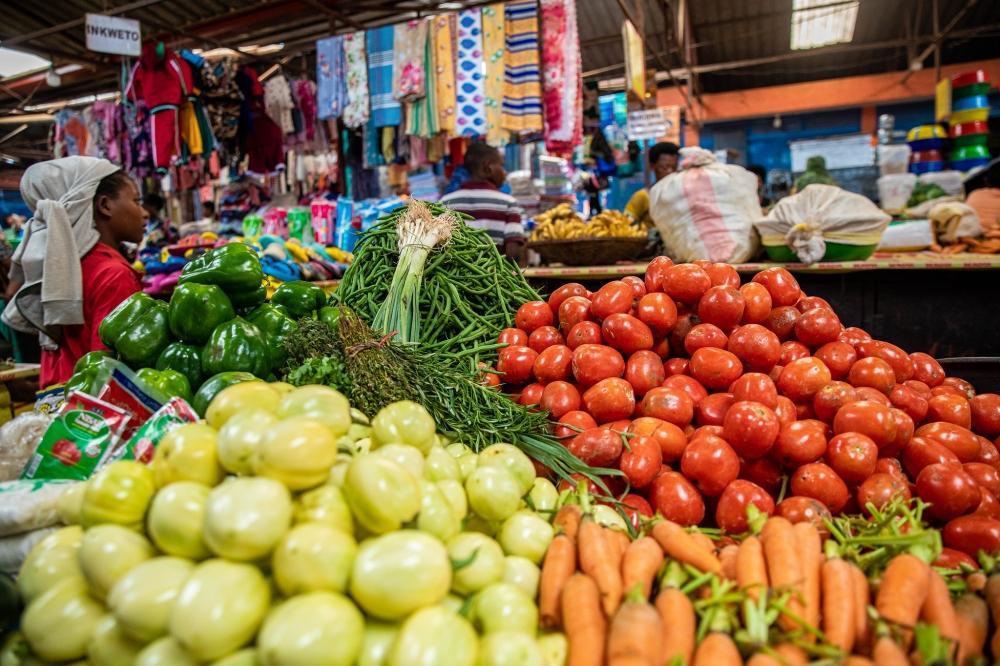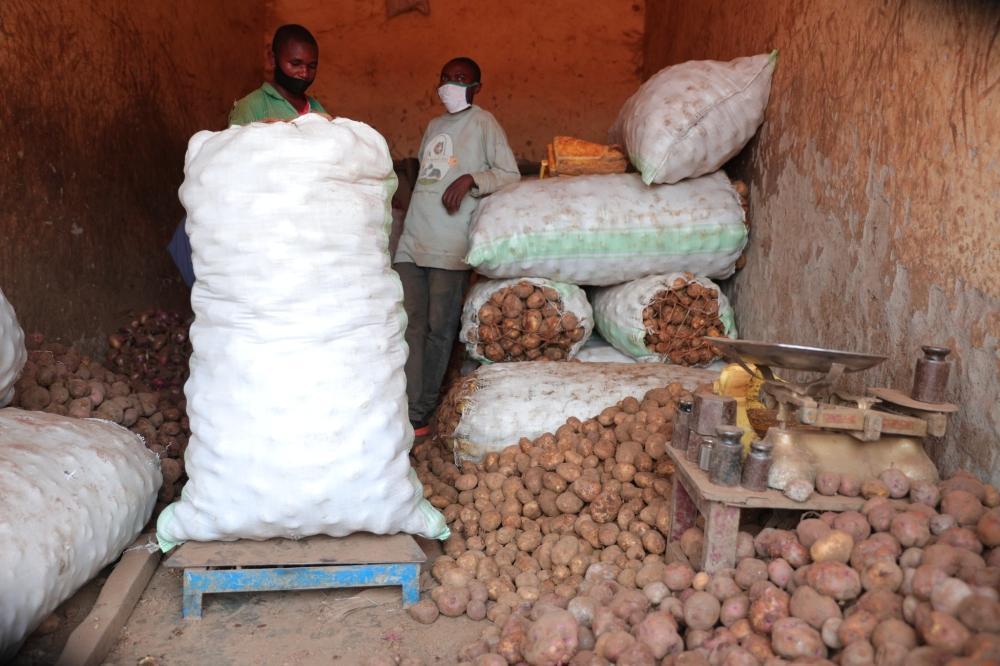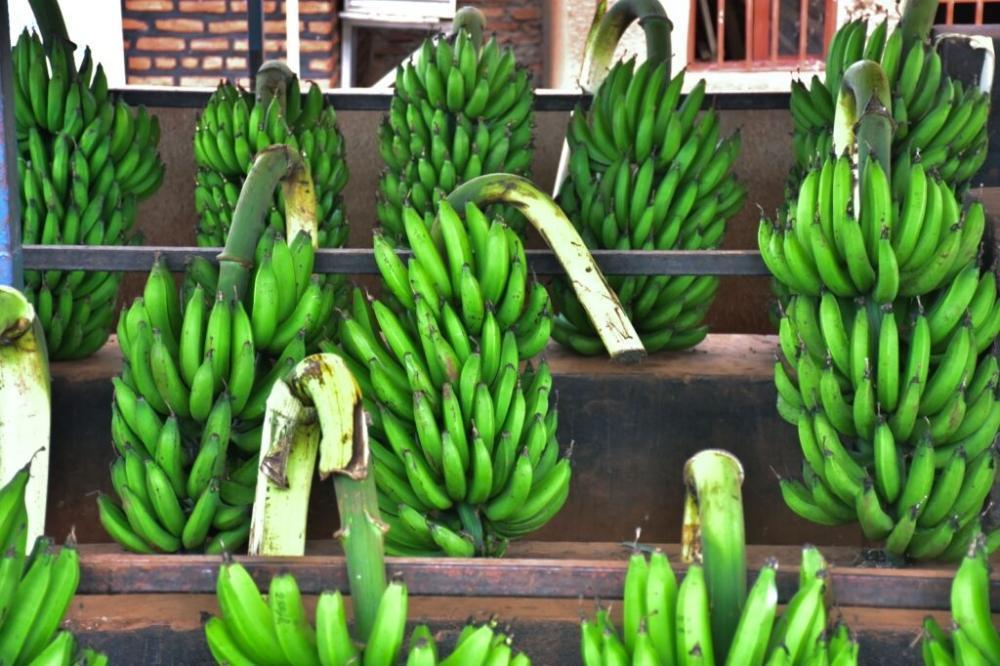Africa-Press – Rwanda. In bustling markets in the City of Kigali, shoppers and sellers are feeling the pinch. Tomatoes that once sold for Rwf 200 now go for Rwf 500 at bare minimum while a small bucket that used to cost Rwf1,500 is now Rwf2,500.
Similarly, the price of Irish potatoes has doubled in price, same as bananas and other food items like beans and groundnuts. On the other hand, traders are reeling from declining customer numbers.
For some Rwandan households, the rising cost of food has turned daily meals into careful calculations due to the hike in food prices, cutting some items off the menu.
“Many of the food items have increased in price because we also buy from wholesalers at a high cost,” says Therese Nikuzwe, a food vendor in Kimironko, Kwa Mushimire, blaming the increase in farmgate prices for the hike in wholesale and retail prices.
According to the April 2025 Consumer Price Index report from the National Institute of Statistics of Rwanda (NISR), general inflation increased by 6.6 percent year-on-year.
Inside a potato store in Nyabisindu in Remera in Kigali. Sam Ngendahimana
In urban areas, the rise was 6.3 percent, largely driven by food and non-alcoholic beverages, which surged by 7.9 per cent—a sharp monthly jump of 2.7 per cent from March to April.
Fresh produce such as vegetables rose by nearly 8.5 per cent, meat by 33.8 per cent, and restaurant meals by nearly 15 per cent. Behind the percentages are real-life stories: people revising their food baskets, small-scale vendors losing customers, and farmers scrambling for consistent yields.
What exactly is fuelling this surge in food prices across Rwanda?
Climate shocks and seasonal shortages
A key contributor is climate-related disruption. Unpredictable rainfall and a shorter rainy season have affected staple crops including beans, maize, and vegetables. In some regions, farmers lost entire harvests to flooding or planted too late to yield viable produce.
Eugene Nsanzimana, a farmer based in Musanze district, Northern Province, explained that many farmers experienced a poor harvest due to heavy rains on one part, which damaged crops last season, while in other parts of the country like the Eastern Province and the Southern Province, farmers faced a challenge of insufficient rain.
These shocks in agricultural production have led to supply shortages, creating a mismatch with rising demand and pushing food prices up.
In fact, as Minister of Trade and Industry Prudence Sebahizi confirmed, price hikes are mostly influenced by shortages during the transition period between growing and harvesting crops in the agricultural season.
“There is a temporary shortage in the market as the country and the region awaits the harvesting of Season B 2025 crops.”
This seasonal lag is directly affecting availability and putting upward pressure on prices, especially for staple food items.
Transport and fuel costs
Another major factor contributing to the hike in prices is transportation. Rwanda’s landlocked geography makes its food supply chain highly sensitive to fuel prices, which have been steadily increasing since late 2024.
Vendors and farmers are forced to pass on these additional costs to consumers. Pacifique Mugisha, a food vendor who delivers directly to clients, noted that rising fuel costs have made transportation more expensive, especially for goods brought in from Nyabugogo, leading him to raise prices just to stay afloat.
Imported inflation and exchange rate pressures
The situation is partly compounded by Rwanda’s reliance on imported goods such as rice, wheat, and cooking oil. When international prices spike or the Rwandan franc loses value against the dollar, these items quickly become more expensive.
Minister Sebahizi pointed out the franc depreciating against the dollar has partly contributed to the problem.
“The exchange rate has also contributed to increased costs, especially for imported food items,” he said.
As a result, even households that traditionally relied on staples like cooking oil or packaged goods are now faced with significantly higher prices due to global inflation being felt locally.
Urbanisation and changing consumption patterns
Urbanisation and shifting dietary preferences are also contributing factors. As more Rwandans move to cities, demand is growing for diverse food options like fruits, dairy products, and processed snacks.
These items require better logistics and, in many cases, imported inputs or refrigerated transport, which further escalates costs. However, supply has not kept pace with demand, leading to persistent price pressures on perishable goods.
Vendor perspectives on current prices in Kigali markets
Mugisha provided a snapshot of prices in and around Kimironko Market and food stores near Kwa Mushimire. A kilogram of matooke now costs Rwf 550, Irish potatoes (particularly the Kinigi variety) cost Rwf 780, while greens range between Rwf 500 and Rwf 600.
A kilogram of onions goes for Rwf 800, tomatoes for Rwf 1,400, and ginger sells at an eye-watering Rwf 3,000. These prices represent a general increase of between 30 and 50 percent across most key perishables in just six months, though exact figures vary slightly depending on location and season.
In Kabeza Market, vendor Hamida Ingabire described a similarly steep rise in prices. She sells local chicken for Rwf 7,000, while specialty breeds can go for Rwf 8,000 or even Rwf 9,000. Fish prices vary according to weight, but smaller types fetch Rwf 6,000 while some go as high as Rwf 12,000.
Beans and dried legumes are now being sold for Rwf 1,500 to Rwf 2,500 per kilogram, and vegetables for Rwf 600. She added that even common cooking ingredients like bananas, ginger, and cassava have seen significant price hikes, with cooking oil now up by 50 to 200 percent in some areas.
The role of restaurants and hotels
Beyond farms and trucks, the food inflation trend is closely tied to the hospitality sector. Data from April shows that restaurants and hotels are playing an outsized role in pushing up overall prices, with meal and beverage prices increasing by over 14 percent compared to the same period in 2024.
The sector’s growing demand has intensified competition for staple food like meat, vegetables, and oil—leading to further price increases across the board.
Supply chain inefficiencies
Much of the price hike stems not just from immediate pressures, but from structural issues in the country’s food system. Post-harvest losses remain high—by some estimates, up to 40 percent of food produced is lost before it even reaches consumers.
This is due to a lack of storage facilities, inadequate packaging, and long travel distances, especially for perishable foods. Without reliable cold chains or coordinated distribution systems, perishable items spoil quickly, especially in hot or humid conditions.
A case in point are vegetables which are predominantly grown in the Western and Northern Province districts, where farmers recently complained about losing their tomato harvest due to transportation challenges.
Another persistent issue is the role of intermediaries. Many farmers still depend on middlemen to transport and sell their produce, who often take sizable margins while leaving the end consumer to bear the final cost.
While farmer cooperatives and direct-to-market models are expanding, they remain limited in reach and lack the infrastructure to fully replace traditional trade routes.
What to look out for in the coming months
The socio-economic impact of rising food prices affects low- and middle-income families most. Many households are revising their diets—cutting out meat, reducing portions, or relying on cheaper options.
“We decided to cut out meat. We now buy it once a week because of the high cost,” says Marie Claire Mutesi, who often shops from Kimironko market. She adds that the cheaper option now is to buy ‘bones’, locally known as ‘Imifupa’, and cook them with ‘Isombe’, rather than buy beef or goat meat.
Recognizing the complexity of the issue, Sebahizi said some of the factors behind the hike in food prices go beyond Rwanda as a country.
“Rising food prices are a complex issue influenced by both short-term and long-term factors, including global events, supply chain disruptions, climate change, and increased demand,” he said.
“It is important to note that the Ministry does not regulate food prices. Pricing is determined by the market through the dynamics of supply and demand,” he added.
Government response
The Rwandan government acknowledges the strain and is taking steps to stabilise food prices. These include investments in irrigation to reduce dependence on rain-fed agriculture, subsidies for essential farm inputs like fertilizer and improved seeds, and expansion of the Strategic Grain Reserve to buffer against future shortages.
In addition, Sebahizi noted regular monitoring and assessment is done to ensure that prices are not flouted by traders and also to make sure that shortages are dealt with as they come.
“The Ministry is closely monitoring the situation and working in collaboration with the private sector to ensure that essential food products remain available in the market.”
Efforts are also underway to upgrade rural infrastructure and reduce transport costs, especially for cooperatives and smallholder farmers, according to the budget paper recently presented in Parliament.
But for vendors like Mugisha and Ingabire, before these changes are implemented, food prices are likely to continue going up, as the dry season approaches.
Mugisha said that he no longer gets as many orders as he used to, with some of his regular customers reducing the frequency of ordering food items.
His frustration is shared by Ingabire, who also says that her regular clients are no longer coming to buy basic goods, and sales have fallen despite increasing inventory costs. She however remains optimistic that things will improve before the end of the year.
Tackling challenges to ensure food security
For now, the outlook remains cautious. Experts warn that without deeper structural reforms—such as strengthening cold chain infrastructure, supporting rural logistics, and improving cooperative market access—food price volatility will persist.
As Rwanda continues to urbanize and modernize its food systems, building resilience at every stage from farm to fork will be essential going forward.
The April CPI report indicates that inflation is being driven not only by external shocks but also by internal vulnerabilities. While short-term fixes like subsidies and reserves can help soften the blow, the long-term solution lies in transforming the food supply chain itself.
As of today, food prices in Rwanda are largely determined by global price shifts, seasonal weather patterns, and fragile domestic logistics – issues which are mostly external but doubling up on local agriculture productivity, especially next season, would help cushion the citizens in the coming months, going into 2026.
For More News And Analysis About Rwanda Follow Africa-Press








